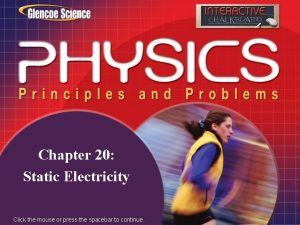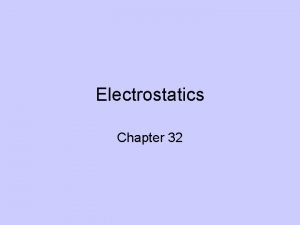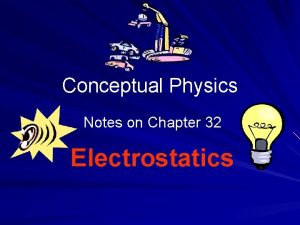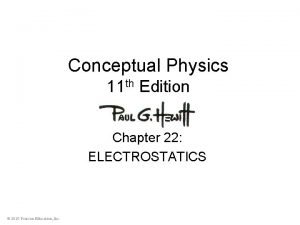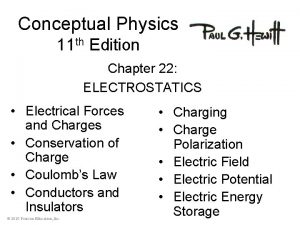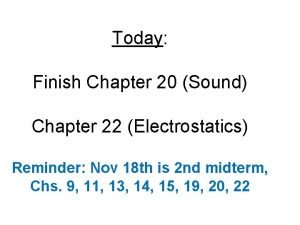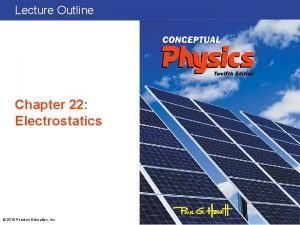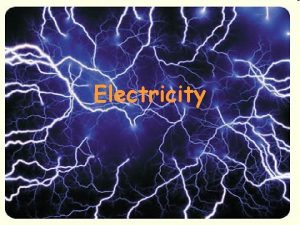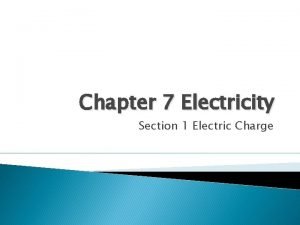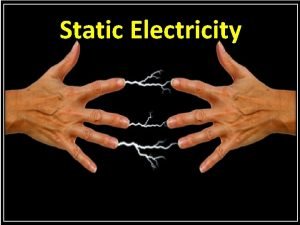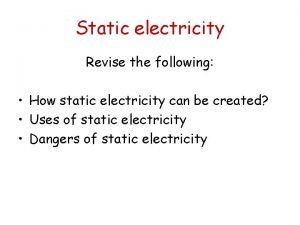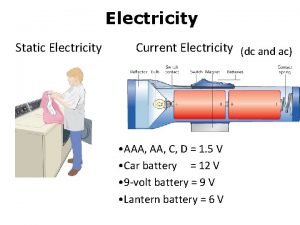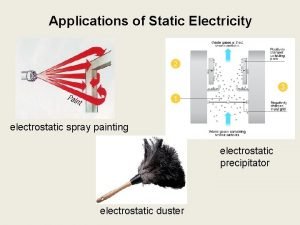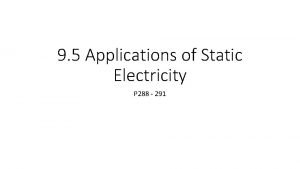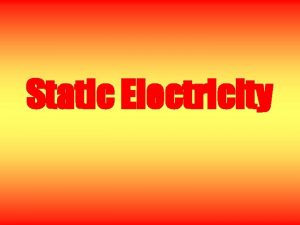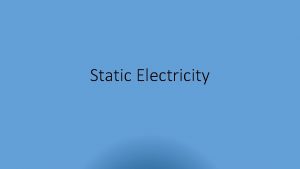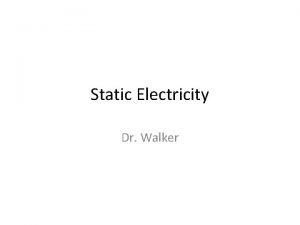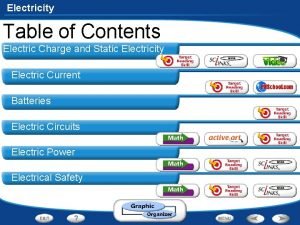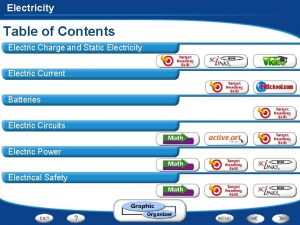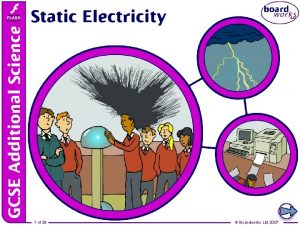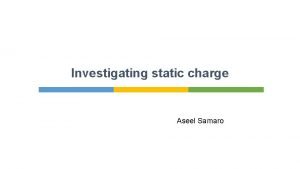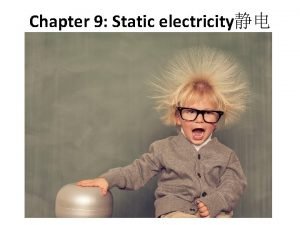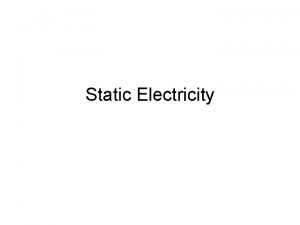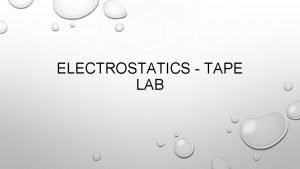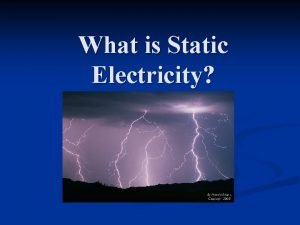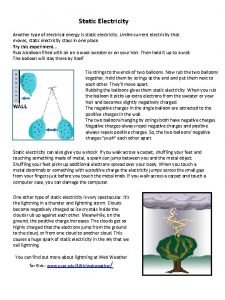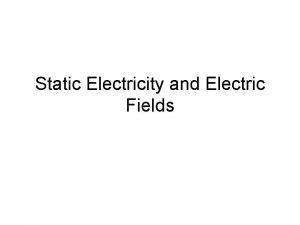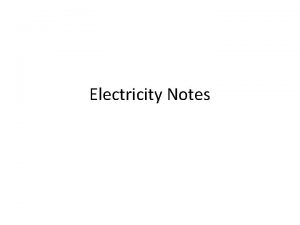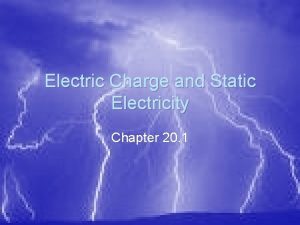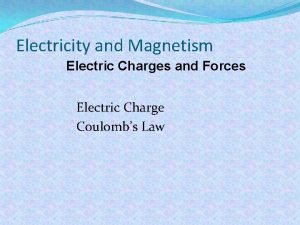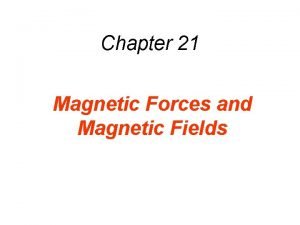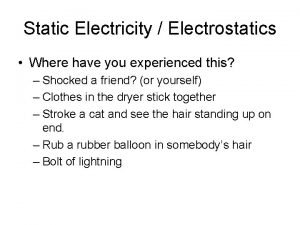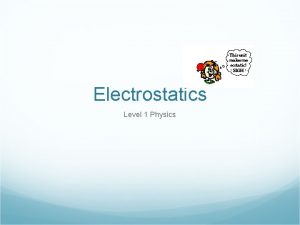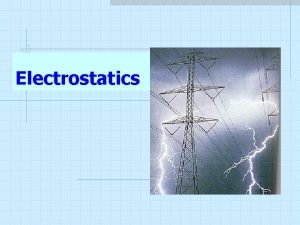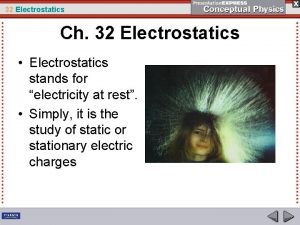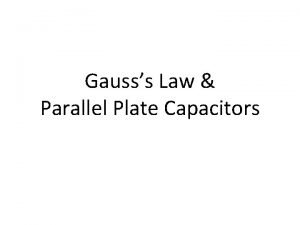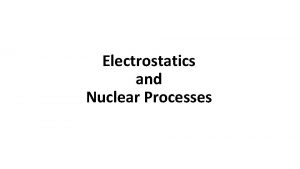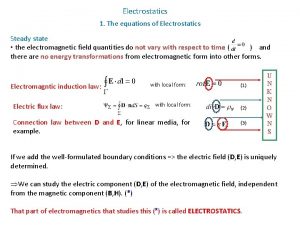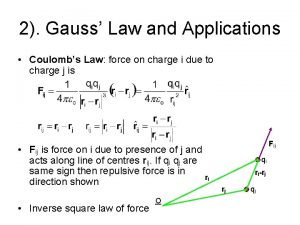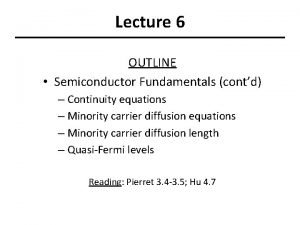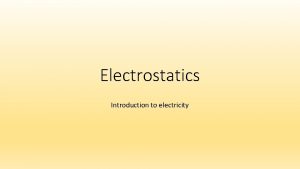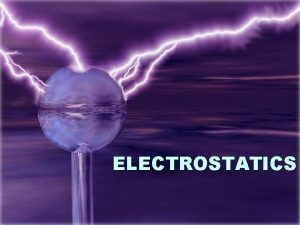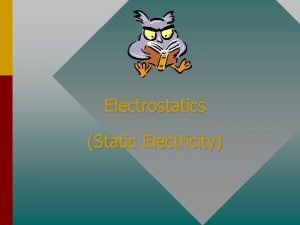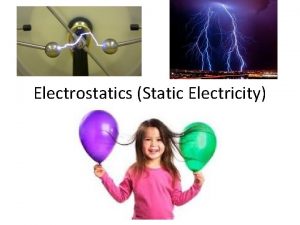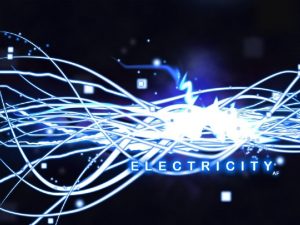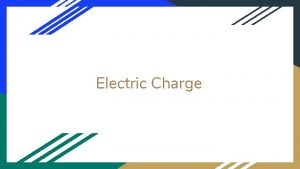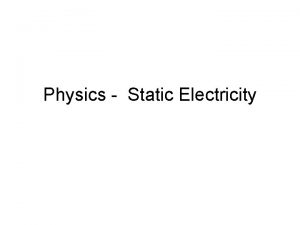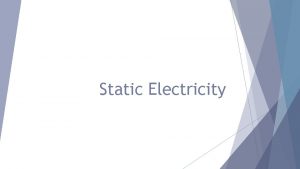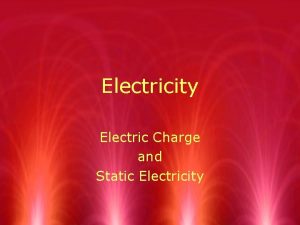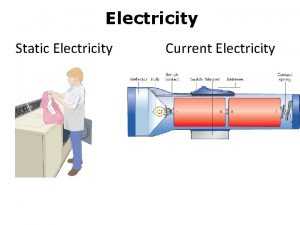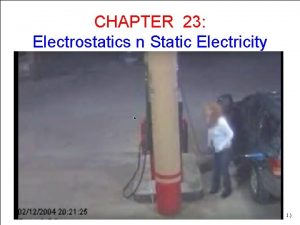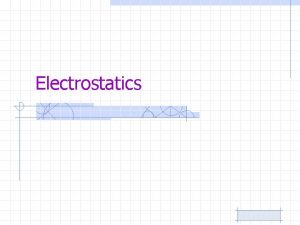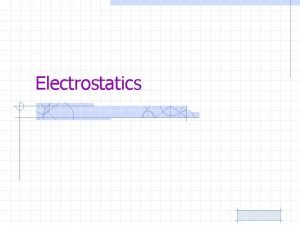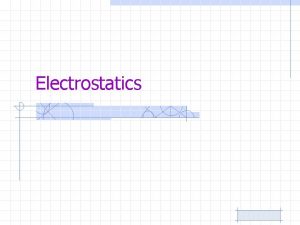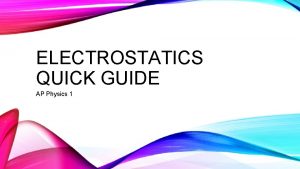CHAPTER 23 Electrostatics n Static Electricity 1 Charge






















































- Slides: 54

CHAPTER 23: Electrostatics n Static Electricity 1. )

Charge What do you know about the atom? 1. ) Its nucleus is made up of electrically neutral neutrons and electrically positive protons. 2. ) On its outskirts in “orbitals” associated with states of energy reside electrically negative electrons. 3. ) Outer shell electrons, called valence electrons, determine how atoms will combine with one another to make molecules. Bonding types are: a. ) Covalent bonding happens when valence electrons are shared between adjacent atoms. Covalent bonding does not allow electrons to migrate throughout a structure. It is characteristic of insulators. b. ) Metallic bonding happens when valence electrons can migrate freely throughout a structure. It is characteristic of conductors. c. ) Ionic bonding happens when atoms have an unbalanced number of protons and electrons, hence are electrically charged. This kind of bonding is not going to be a player in the materials we will be considering here. 2. )

In an electrically neutral atom: electron here as much as it is here! The average position of its protons is where? (In the nucleus at the center of the atom!) The average position of its electrons is where? (Even though the electrons are “moving” around the nucleus at speeds up to 14, 000 miles/second, their AVERAGE position is at the center of the atom where reside the protons. ) electron’s average position at center Bohr atom This is why normal atoms are electrically neutral. Essentially covering every positive charge in an electrically neutral atom there sits a negative charge to null the positive out. Although there will be time when we talk about the movement of positive charge, in reality, protons are fixed stationary in the nucleus with electrons ALWAYS being the entities that move onto or off of an object. A positively charge object is just an object that has had electrons removed; a negatively charged object an object upon which free electrons have been added. 3. )

A glass rod, which easily releases electrons, is rubbed vigorously by a silk clothe, which easily accepts electrons. This leaves the rod electrically positive. Consider an electrically neutral conducting sphere (notice that for each proton, there is an electron covering it)? What happens when the two are brought together? The ball’s electrons, which are free to move because the bonding is metallic, will migrate toward the positive charge on the rod leaving the far side of the ball electrically positive and the near side electrically negative (I’ve omitted all the neutral combinations). Charge separation like this is called polarization. With this, the electrical repulsion between the rod and ball’s far-side positive charge will be overcome by the electrical attraction between the rod and the ball’s near-side negative charge, and a net force of attraction will exist. 4. )

If the rod was negative? The ball’s electrons would be repulsed by the rod migrating to the far side leaving the near side electrically positive. The attraction of the positive side, being nearer, would yield a net attraction between the rod and the ball, and the net effect would be the same as in the other case. What if the rod touches the ball? The rod is an insulator, so charge stays put on it (charge can’t migrate as it would in a conductor). As such, at the point of contact only, electrons will transfer from the rod to the ball (if the rod was positive, the electrons would move from the ball to the rod--it is ALWAYS negative charge—electrons--that move). This will leave the ball electrically negative. Even though the electrons will migrate to the far side of the ball, their numbers will effect a net electrical repulsion. electrons jump This is called CHARGING BY CONDUCTION. 5. )

Grounding is the connecting of a structure to a reservoir of charge, often quite literally the ground, to electrically neutralize the structure. circuit symbol for ground The symbol for ground in an electrical circuit is shown to the right. Touching our polarized ball on the side opposite the rod (I’d like to thank Michelangelo for the hand) will “ground” that side, allowing free electrons to run from the hand to the ball, neutralizing that side of the ball. electrons run onto ball from ground Remove the hand rod, and the electrons will redistribute themselves leaving you with a negatively charged ball. This is called CHARGING BY INDUCTION (you are inducing a charge separation, then removing charge by grounding). 6. )

How would this change if the ball was an electrically neutral AND made out of an insulating material? They wouldn’t! Yes, insulators are covalently bonded, which means their valence electrons cannot move around freely as valence electrons do in a conductor. You won’t get mass migration due to the charge on the rod. But other stuff happens! The positive charge at the center of each of the atoms making up the insulating material are fixed in their immoveable nuclei, but the negatively charged electrons move in orbitals around that center. no mass migration of electrons Bohr atom if rod positive, electron spends most of its time here Normally, their average position is at the nucleus, but when a charged rod comes near with its associated electrical force, the electrons respond to that force shifting the average position of the negative charge. electron usually spends same time here as here electron’s average position shifts to here, producing polarization! The net effect is that the atom becomes temporarily polarized. This is called the van der Waal effect. 7. )

In other words, the atoms of a covalently bonded structure (an insulator) can become minipolarization units motivating the surface nearest the rod to take on a temporary surface charge density (temporary in the sense that it will stay there as long as the rod is present). (In fact, the far side of the object will take on an oppositely charged surface charge density. ) negative surface charge density positive surface charge density This will produce a temporary force, a van der Waal force, between the rod and the insulating material. General bottom line: FREE CHARGE close to ANY structure, be it an insulator or a conductor, will motivate the electrons in the structure to arrange themselves in such a way as to produce an attractive force between the free charge and the structure. THIS IS ALWAYS TRUE! 8. )

Mr. White’s Charging by Conduction Slide 1 “Charging by conduction” occurs when a charged conductor (metal) touches a neutral conductor: some free electrons pass from one object to the other. 9. )

Mr. White’s Charging by Conduction Slide 2 Note from Fletch: If both rods are conductors and they are identical, the charge will distribute evenly (as shown) between the two. 10. )

Mr. White’s Charging by Induction Slide 1 “Charging by induction” occurs when a charged object is brought near a neutral conductor. 11. )

Mr. White’s Grounding Slide The term grounding refers to connecting a conductor to the literal ground, ie. the earth. The earth readily accepts or gives up electrons— it has plenty to spare—so grounding a conductor allows for the flow of charges. What effect this has depends on the situation. 12. )

Mr. White’s Electroscope The electroscope is a simple device designed to detect the presence of electric charges. Movable leaves (of gold? !) connected to a metal ball separate when a charged object is brought near, or touched to the ball. But why? 13. )

Shielding When free charge is placed on a conductor, electrical repulsion will motivate electrons to move as far away from other electrons as possible. Consequence: Force electrons onto a flat conducting surface. At some point, the free electron population already on the surface will provide such a large repulsive force that no additionally placed electrons will make it onto the surface. When that happens, the electrons will be evenly distributed over the surface. Bend the surface and you can force MORE electrons on, increas-ing the surface charge density. Why? Because there is now material between the electrons, diminishing their repulsive effect on distance electrons. This phenomenon is called SHIELDING. Oddly shaped conductors will have different charge densities, depending upon the severity of their curvature. The extreme: the lightning rod, a pointed piece of metal insulated from a house. It accumulates HUGES amount of charge at its end point, attracting potential lightning strikes away from the house. surface charge density evenly distributed surface charge density increased charge density really high charge density relatively low 14)

Coulomb’s Law When two point charges are in the vicinity of one another, they will feel a Newton’s Third Law, action/reaction electrical force that will be attractive if the charges are unlike and repulsive if the charges are like. According to Coulomb, the magnitude of that force will be proportional to the product of the magnitude of the two charges (the symbol for charge is q) and inversely proportional to the square of the distance between the two charges. The proportionality constant is usually defined in terms of another constant called the permittivity of free space (this is a measure of a vacuum’s resistance to forming an electric field—something we’ll talk about later). Numerically, So mathematically, Coulomb’s Law is written as: As , this is sometimes defined as k and Coulomb’s Law is written in some books as: 15. )

Important Points Coulomb’s Law only works between two POINT CHARGES. If you want to deal with more than two charges, you need to execute a vector sum of all the Coulomb forces acting on a charge due to all the point charges in the system. Coulomb’s Law is only useful in static situations. Charge in motion is a whole other kettle of fish. The unit for charge in the MKS system is the COULOMB. In that unit: There is Coulombs worth of charge on an electron; There is Coulombs worth of charge on a proton; 16. )

NEVER include a charge’s sign when using Coulomb’s Law. The direction of force generated by a point charge on another point charge, is determined by attraction or repulsion between the charges (i. e. , whether they are like or unlike charges) and how the coordinate axis is set up. Beyond determine likeness or unlikeness, the sign of the charges has nothing to do with direction in a coordinate axis setting! To wit: Example 1: A positive charge is located at the origin. A negative charge is located a distance -a units along the x-axis. What is the force on due to the presence of ? According to Coulomb’s Law: Why in the +x-direction? Because opposites attract, and the direction of attraction on in this case is to the right! If it had been located at x = a, the magnitude would have been the same but the direction would have been in the –xdirection! REGISTER! If you’d included sign in the Coulomb expression, you’d have ended up with a force value that was NEGATIVE, which would have made NO SENSE given the coordinate set-up. USE COULOMB ONLY FOR MAGNITUDES! 17. )

Example 2: Consider the charge configuration shown. Where could you put a positive charge q if it is to feel no net electric force? As a small side point, it doesn’t matter whether q is positive or negative— zero force is zero force! Observation: The point must be along the x-axis. But where? It can’t be between the two charges because the positive charge will push q to the left while the negative charge will also pull q to the left. . . hence no place in between where the net force can be zero. It can’t be in the positive region to the right of the origin because the 2 C charge will be both larger and closer to q than will be the case for the -. 5 C charge. . . hence no place in that region where the net force can be zero. Apparently, the coordinate must be in the -x-region to the left of the origin. 18. )

Defining x to be the noforce position of q, we can write Coulomb’s Law between q and each of the charges: Noticing that the positive charge is producing a negative force (it’s repulsing q), and the negative charge a positive force, signs need to be added after the fact. Summing these forces vectorially, we get: 19. )

Example 3: Determine the force on q. Begin by determining the direction and magnitude of the force on q due to the presence of each of the charges in the system. To add the forces vectorially, we need to break the forces into components. At this point, we need a little trickery. Looking at the shaded triangle, the sine and cosine can be written as: and 20. )

Putting it all together: 21. )

Electric Fields Place a “field producing” point-charge out in space. That charge will produce an electrical disturbance in the region around it. To detect that disturbance, place a test charge in the region. As long as the disturbance is there, the test charge will feel a force on it. If you measure the force on the test charge q, THEN DIVIDE BY THE MAGNITUDE OF THE TEST CHARGE, you end up with a force-related quantity that is dependent upon: The size of the field producing charge Q, and The distance from the field producing charge Q. It will have NOTHING TO DO with the size of the test charge. 22. )

Called an ELECTRIC FIELD, this idea of measuring the amount of force per unit charge AVAILABLE at a point due to the presence of fieldproducing charge can be (and is) associated with any charge configuration. electrical disturbance exists An ELECTRIC FIELDs exist wherever there is charge. For the electric field to exist, there doesn’t need to be present a secondary charge to feel the effect of the field-producing charge. And because E-flds tell us how much force is available PER UNIT CHARGE at a point, the electric field is defined as: Example 3: What force does a 2 C charge feel in an electric field ? 23. )

Subtleties Concerning Electric Fields An electric field, being a modified force field, is a vector. So how is its direction defined? The direction of an electric field is defined as the direction a POSITIVE TEST CHARGE will accelerate if released in the field at the point of interest. DON’T GET AHEAD OF YOURSELF on this. You will see how it all plays out shortly. For now, just take in the definition. Example 4: At point a designated in each of the scenarios below, draw the direction of the electric field generated by the field-producing charge configuration. surface charge on outside edge of hollow, insulating sphere direction of E. fld no E. fld 24. )

Continuing with Subtleties By definition, positive charges freely accelerate in the direction of electric fields. As such, negative charges must freely accelerate OPPOSITE the direction of electric fields. So whereas we DIDN’T use a charge’s sign when using , leaving the force’s sign determination to attraction/repulsion characteristics coupled with where the charge was in the coordinate system, we NEED to include charge sign in using. To see why, reconsider Example 3. Example 5: So back to Example 3, but with a twist. What force does a -2 C charge feel in an electric field ? When the charge was positive, the calculation yielded , so we’d expect the solution to this problem to be negative that value. But how to get that negative. Although this is REALLY NOT KOSHER, IF we use the sign of the charge in our relationship, we get the right answer (not Kosher because the sign of a charge has nothing to do with the sign of a force). Using that, we can write: Point taken? 25. )

A Specific Case--The Electric Field Generated by a POINT CHARGE Example 6: Derive a general expression for the electric field generated by a point charge Q? If we placed a positive test charge q a distance r units from Q, the magnitude of the force on q (according to Coulomb’s Law) would be: By definition, the magnitude of the electric field is , so: 26. )

Observations: If you are ever working with a field-producing charge that is a POINT CHARGE, you now know its electric field will equal: When talking theoretically, the direction of this field will be radially outward if the field-producing charge is positive (a positive test charge will accelerate away from a positive field-producing charge—that’s how electric fields are defined. . . the direction a positive test charge will accelerate if put in the field and released) and radially inward if the field-producing charge is negative. As such, with the sign of the charge included (again, not kosher, but it gives the correct sign for the vector), the E-fld as a vector is often presented as: For most problem solving, though, we work in Cartesian coordinates. In that setting, use the relationship to determine the magnitude of the E-fld and determine the direction using the “acceleration of positive test charge” question. 27. )

Example 7: Derive an expres -sion for the electric field at (x, 0). This is very similar to Example 3 (and because the charge q was positive in that problem, the forces on it and the direction of the electric fields will even be the same). The difference? No need to include the test charge q, just work with E: notice, no charge here, just a point in space Defining the field directions and magnitudes, then break into components: You’d use the same trickery ( like before. ) and finish the problem just 28. )

Putting it all together: 29. )

Example 8: Derive an expression for the electric field at the origin due to a rod with charge -Q uniformly distributed over its length L. Being an extended charge distribution, we need to break the rod into a differentially small bit determine of charge, the electric field magnitude and direction as it exists at the origin due to that bit of charge, then sum that differential electric field over the entire rod. To do this, we will need to define a linear charge density function (yes, this looks just like the linear mass density function. . . that’s OK, we can use the same symbol to do the more than one thing): As always, the density function can be written in differential terms as With that, we have: . 30. )

Example 9 (a non-AP question): Derive an expression for the electric field at an arbitrary point y = b on the y-axis due to a rod with charge Q uniformly distributed over its length L. As usual, define the direction and magnitude of the differential E-fld due to an arbitrary Once differential charge dq on thedone, rod. break it into component parts using the sine and cosine trick: 31. )

Without doing the integrals (the set-up is what is important, and something like this isn’t something the AP folks are going to throw at you), the electric field is: 32. )

Example 10: A ring situated in the y-z plane (as shown) has –Q’s worth of charge on it. Derive an expression for the E-fld at (x, 0). As usual, begin with a differential bit of charge -dq and determine the direction and magnitude of the differential electric field at (x, 0) due to that bit. Use any symmetry that exist to simplify the summing task. these components are the same. these components cancel out. Noting that x and R are constants, and that the cosine is: we can write: where the direction, by inspection, is 33. )

Example 11: Derive an expression for the electric field at the center of a halfhoop of radius R with Q uniformly distributed over its surface. This is a little bit tricky as the differential bit of charge dq is located on an arc What needs to be noticed is that the arclength ds subtended by an angle is: So magnitude, direction and components of d. E due to dq become: Using a linear charge density function, then, we can write: 33. )

An additional bit of trickery is involved in exploiting the symmetry of the set-up. Notice there is a second dq on the right side at an angle that will produce a mirrorimage differential electric field to our original bit of charge. The x-components of the two fields will add to zero, so all we really have to deal with is the y-component. With the linear charge density as: and d. E as: we can write: 34. )

Example 12: A solid disk of radius R situated in the x-z plane (as shown) has Q’s worth of charge on it. Derive an expression for the E-fld at (x, 0). We already know the E-fld function along the x-axis for a charged hoop. So taking the hoop’s charge to be dq and its radius to be r, we can write the magnitude of the differential E-fld (in the x-direction) due to a differentially thin hoop on the face of the disk to be: As always, a surface density function can be defined as both: and, with the area of a hoop equaling the circumference of the hoop times its thickness: 36. )

Summing over all of the differential hoops yields: rewriting 37. )

If you would like to look at more exotic, most-probably non-AP electric field problems, look at the Where r You Going Power. Point on the class Web site. 38. )

Electric Fields Lines A method to visualize what an electric field looks like is wrapped up in what are called electric field lines. You saw an example of field lines when I introduced the idea of an electrical disturbance around a charge (see figure to the right). The lines are designed to tell you very specific information about the charge configuration: electric field lines for positive point charge As electric field lines move away from positive charge and toward negative charge (remember, the direction of an electric field is defined as the direction a positive test charge would accelerate if released at the point of interest), electric field lines always leave positive charges and enter negative charges. The number of line that leave a charge is proportional to the size of the charge. The distance between lines gives you a relative feel for the strength of the field at a particular point—the closer the lines, the stronger the force. That means a constant E-fld will have field lines that are parallel and equidistant apart. The lines gives you a relative feel for the direction of the field at a given point, and skirt areas where an E. fld is zero. constant E-fld 39. )

(courtesy of Mr. White) 40. )

(courtesy of Mr. White) 41. )

(courtesy of Mr. White) 42. )

(courtesy of Mr. White) 43. )

(courtesy of Mr. White) 44. )

(next five pictures courtesy of Mr. White) 45. )

46. )

(next five pictures courtesy of Mr. White) 47. )

48. )

49. )

50. )

Example 13: A charge –Q and mass m is fired into a cavity bounded by two metallic plates of length L. The plates are d units apart. The charge initially moves along the cavity’s central x-axis with velocity (see sketch). Assuming gravity acts downward: a. ) The hope is that Q will move straight along the x-axis even though gravity is acting upon the mass. An E-fld is placed between the plates to counteract gravity. In what direction must that field be? Also, what kind of charge must exist on the top and bottom plate to effect that field? If the electric FORCE must be upward to counteract the downward force of gravity, and if the force on a negative charge is opposite the direction of an electric field (think about how the direction of an electric field is defined), the E-fld must be downward (hence producing an electrical force upward). (NOTE: The easiest way to think through this is to assume the charge is positive, determine the E-fld for that particle, then reverse you solution. ) The charge configuration needed to generate a downward electric field, given that field lines leave positive charges, is positive charge on the top plate and negative charge on the bottom plate. 51. )

b. ) What must be the electric field magnitude to effect this straight-line motion? This is a Newton’s Second Law problem. Noting that the magnitude of the electric force is , where q does not carry its sign, we can write: c. ) Given this E-fld, if this experiment had been carried out in space: i. ) What path would the charge take after the firing? ii. ) Given the electric field as calculated, what velocity would the charge require to just barely clear the cavity 2 without crashing into its wall? (see sketch) 3 1 52. )

Example 14—courtesy of Mr White: Secret Agent 008 is in a rather sticky situation. A climbing rope of negligible mass suspends our hero over a pool of hungry sharks. The space above the pool is permeated by a uniform electric field of 100 N/C. Luckily, Agent 008 is wearing a special Adjustable Electric Charge Body Suit prepared for him by the ingenious minds at the Imperial Research and Development Lab. a) In order to stay alive long enough to devise an escape plan, 008 must select a charge for his suit that will enable him to keep the rope at a minimum angle of 20° to the left of vertical, as shown in the drawing above. If he weighs 75 kg, what is the magnitude and polarity of the charge Agent 008 should set the suit for? He is going to need an electric force opposite the direction of the Efld, so it will need to be a negative charge. With the f. b. d. : and 53. )

b) Agent 008 accidentally selects a charge of +10. 0 Coulombs for his body suit. To what angle (relative to the vertical) does his body swing now? A positive charge will swing him in the direction of the E-fld, so the sketch will be a mirror image of what is seen and you’ll just have to do the math (it’s the same math) to figure out the angle. c) Unfortunately, Agent 008’s rope has been weakened--when the rope reaches this new angle, it snaps. What was the tension in the rope just before it broke? Go back to either of the equations used to solve Part b and solve for T. 54. )
 Static electricity and current electricity
Static electricity and current electricity Current electricity
Current electricity Electricity and magnetism vocabulary
Electricity and magnetism vocabulary Chapter 6 section 1 electric charge worksheet answers
Chapter 6 section 1 electric charge worksheet answers Chapter 20 static electricity answers
Chapter 20 static electricity answers Chapter 32 electrostatics
Chapter 32 electrostatics Chapter 32 electrostatics conceptual physics
Chapter 32 electrostatics conceptual physics Conceptual physics chapter 22 electrostatics answers
Conceptual physics chapter 22 electrostatics answers Conceptual physics chapter 22 electrostatics
Conceptual physics chapter 22 electrostatics Chapter 22 electrostatics
Chapter 22 electrostatics Chapter 22 electrostatics
Chapter 22 electrostatics Section 1 electric charge crossword puzzle answers
Section 1 electric charge crossword puzzle answers Electricity section 1 electric charge
Electricity section 1 electric charge Static electricity
Static electricity Static electricity photocopier
Static electricity photocopier Bill nye electricity worksheet
Bill nye electricity worksheet What year was electricity invented
What year was electricity invented Is static electricity ac or dc
Is static electricity ac or dc Electrons flowing
Electrons flowing How does spray paint use static electricity
How does spray paint use static electricity Static electricity painting
Static electricity painting Stationary electric charge
Stationary electric charge Static electricity examples
Static electricity examples Triboelectric series
Triboelectric series Static electricity
Static electricity Graphic organizer electric current
Graphic organizer electric current Static electricity summary
Static electricity summary Does magnetic field exerts force on a static charge
Does magnetic field exerts force on a static charge Static electricity
Static electricity Static electricity
Static electricity Static electricity by calamityofcolors
Static electricity by calamityofcolors Static electricity tape lab
Static electricity tape lab Static electricity
Static electricity Static electricity one cloud to another
Static electricity one cloud to another What is that
What is that Types of charges
Types of charges Electric charge is
Electric charge is Static electricity by calamityofcolors
Static electricity by calamityofcolors Concept map
Concept map Difference between charge and electric charge
Difference between charge and electric charge Electric force equation
Electric force equation Does magnetic field exerts force on a static charge
Does magnetic field exerts force on a static charge Static accumulator cargo
Static accumulator cargo Electric energy
Electric energy Coloumb to volt
Coloumb to volt Electric charge
Electric charge What is net charge
What is net charge Electrostatics
Electrostatics Electrostatics
Electrostatics Facts about electrostatics
Facts about electrostatics Physics classroom electrostatics
Physics classroom electrostatics Electrostatics
Electrostatics Gauss law in integral form
Gauss law in integral form Type of charging processes
Type of charging processes Continuity equation in electrostatics
Continuity equation in electrostatics




